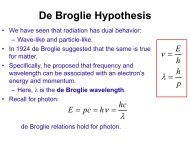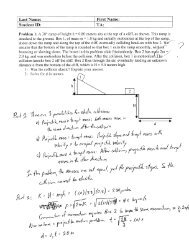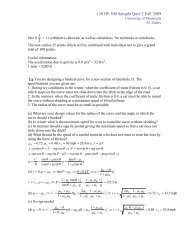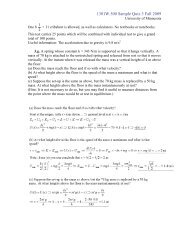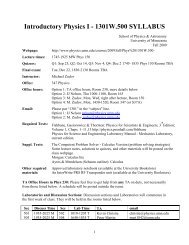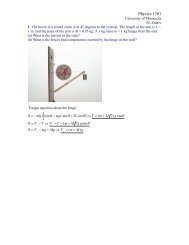Physics 1301 - University of Minnesota
Physics 1301 - University of Minnesota
Physics 1301 - University of Minnesota
You also want an ePaper? Increase the reach of your titles
YUMPU automatically turns print PDFs into web optimized ePapers that Google loves.
<strong>Physics</strong> <strong>1301</strong><strong>University</strong> <strong>of</strong> <strong>Minnesota</strong>M. ZudovYou are designing a banked curve for a new section <strong>of</strong> interstate 35. The specificationsyou are given are:1. During icy conditions in the winter, when the coefficient <strong>of</strong> static friction is 0.15, a carwhich stops on the curve must not slide down into the ditch at the edge <strong>of</strong> the road.2. In the summer, when the coefficient <strong>of</strong> static friction is 0.4, a car must be able to roundthe curve without skidding at a maximum speed <strong>of</strong> 60 miles/hour.3. The radius <strong>of</strong> the curve must be as small as possible.(a) What is the design value for the angle at which the curve should be banked?(b) What is the design value for the radius <strong>of</strong> the curve?(c) In winter what is the maximum speed for a car to round the curve without skidding?(d) What should be the speed <strong>of</strong> a careful motorist who does not want to wear her tires byusing the force <strong>of</strong> friction?Bonus:Assume that the road is not banked.(e) What would be the maximum speed in winter (same radius)?(f) What would be the radius <strong>of</strong> the curve to satisfy condition 2. above?μ = 0.15, μ = 0.40, vWy : masinθ= N − mg cosθ⇒ N = masinθ+ mg cosθx : ma cosθ= mg sinθ− μN= mg sinθ− μmasinθ− μmgcosθ⇒2va =RμW− μ(a) v = 0, μ = μW⇒ tanθ= μW⇒ θ = 8.53° ⇒ a = g1+μμ(b) v = v(d) μ = 0 ⇒ v(e) θ = 0 ⇒ vsinθ− μ cosθtanθ− μ=g = gcosθ+ μ sinθ1+μ tanθ(c) μ = −μ⇒ vS(f) θ = 0, v = v21−μStanθvS, μ = −μS⇒ R =tanθ+ μ gWS22S2μW+ μW=1+μ μμW− 0=1+0⋅μ= 60 mph = 26.8 m/s, f = μN2μWRg =21−μ1−μSμW=μ + μ0 + μW= gR = μWgR = ...(same as above)1−μ ⋅0WSWW2 21−μS⋅0vSvS⇒ R ==0 + μ g μ gW1−μSμWvμ + μ= 183.5 m2S1−μSμWgR = μWgR = μWvμ + μSSSWWWWSSS2vS= 125.5 mg⇒ v = v2SWS⇒ v = vS2μW21−μW1−μSμWμ + μ= 0.72⋅vμW(1 − μSμW)= 0.50⋅vSμ + μWWSSS= 43.5 mph= 30.4 mph
<strong>Physics</strong> <strong>1301</strong><strong>University</strong> <strong>of</strong> <strong>Minnesota</strong>M. Zudovθμθθμθθμθθμθθμθθμθθμθμθcossin:moving rightcossincos:sinat restcossin:moving leftcossincossin0(2)(1)0(2)cossin0(1)??;0)0;0;(,121212122112211112+>+≤≤−−
<strong>Physics</strong> <strong>1301</strong><strong>University</strong> <strong>of</strong> <strong>Minnesota</strong>M. Zudov1. Block (mass m 2 ) is placed on top <strong>of</strong> a prism (mass m 1 , angle α ). The coefficient <strong>of</strong>friction between the block and the prism is μ. Find the maximum and minimumhorizontal accelerations <strong>of</strong> the prism at which the block will not slide.(a) θ = 10°, μ = 0.4, aa − ?yx22: m a sinα= N − m: m a cosα= msinα± μ cosα± μ + tanαa = g= gcosαm μ sinα1mμ tanαaamaxmin222μ + tanα= g = 0.62g1−μ tanα− μ + tanα= g = −0.21g1+μ tanα2g cosα⇒ N = mg cosα+ m a sinαm2acosα− mg sinα± μN⇒ N =± μ22= a = a± μmg cosα± μm a sinα= m a cosα− m212222g sinα⇒2g sinα
<strong>Physics</strong> <strong>1301</strong><strong>University</strong> <strong>of</strong> <strong>Minnesota</strong>M. ZudovBlock (mass m 2 ) is placed on top <strong>of</strong> a prism (mass m 1 , angle α ).Assuming that friction is negligible, find the acceleration <strong>of</strong> the prism, a 1 .(a) θ,m , m211- ?2 y211: ma2 y211y22We assume xa, μ = 01to the right, ySince there is no relative motion along yay= ax : m a= −asinα= N sinα= m21122⊥,up the incline= −ma sinα= N − m g cosα⇒ N = mg cosαsinα− m a22, both the block and the prizm have the same acceleration projections on y2122sin α ⇒ ag cosα− m112a sinαm2cosαsinα= g2m + m sin α122.
<strong>Physics</strong> <strong>1301</strong><strong>University</strong> <strong>of</strong> <strong>Minnesota</strong>M. ZudovA block starts sliding <strong>of</strong>f the top <strong>of</strong> a wedge whose base is equal to l = 2.10 m. Thecoefficient <strong>of</strong> friction between the block and the wedge is equal to μ = 0.140. What angleα corresponds to a minimum sliding time? How would this angle change if thecoefficient <strong>of</strong> friction is set to zero?m = 2.00 kg, l = 2.10 m, μ = 0.140, t = tα − ?a = g(sinα− μ cosα)min, v02l at 2 2l2lx = = ⇒ t = =cosα2 a cosαg cosα(sinα− μ cosα)dcosα(sinα− μ cosα)= −sinα(sinα− μ cosα)+ cosα(cosα+ μ sinα)=dα221= cos α − sin α + 2μcosαsinα= cos 2α+ μ sin 2α= 0 ⇒ tan 2α= − < 0 ⇒ 2α> 90°μ1 ⎛ ⎞=−11α tan ⎜ − ⎟ = 98°⇒ α = 49°2 ⎝ μ ⎠μ = 0 ⇒ α = 45°= 0
<strong>Physics</strong> <strong>1301</strong><strong>University</strong> <strong>of</strong> <strong>Minnesota</strong>M. ZudovA small block A <strong>of</strong> mass m =5 kg is launched <strong>of</strong>f the top <strong>of</strong> a sphere <strong>of</strong> radius R = 1 m.The block breaks <strong>of</strong>f the sphere with velocity v = 2 m/s. The coefficient <strong>of</strong> frictionbetween the block and the sphere is equal to μ = 0.15. Find the angle θ corresponding tothe point at which the block breaks <strong>of</strong>f the sphere.m,R,v,μθ − ?may2v= mR(break - <strong>of</strong>f= mg cosθ− Npoint) ⇒ N= 0 ⇒2vR= g cosθ⇒ θ = cos−1( v2/ gR)= 65.9°




